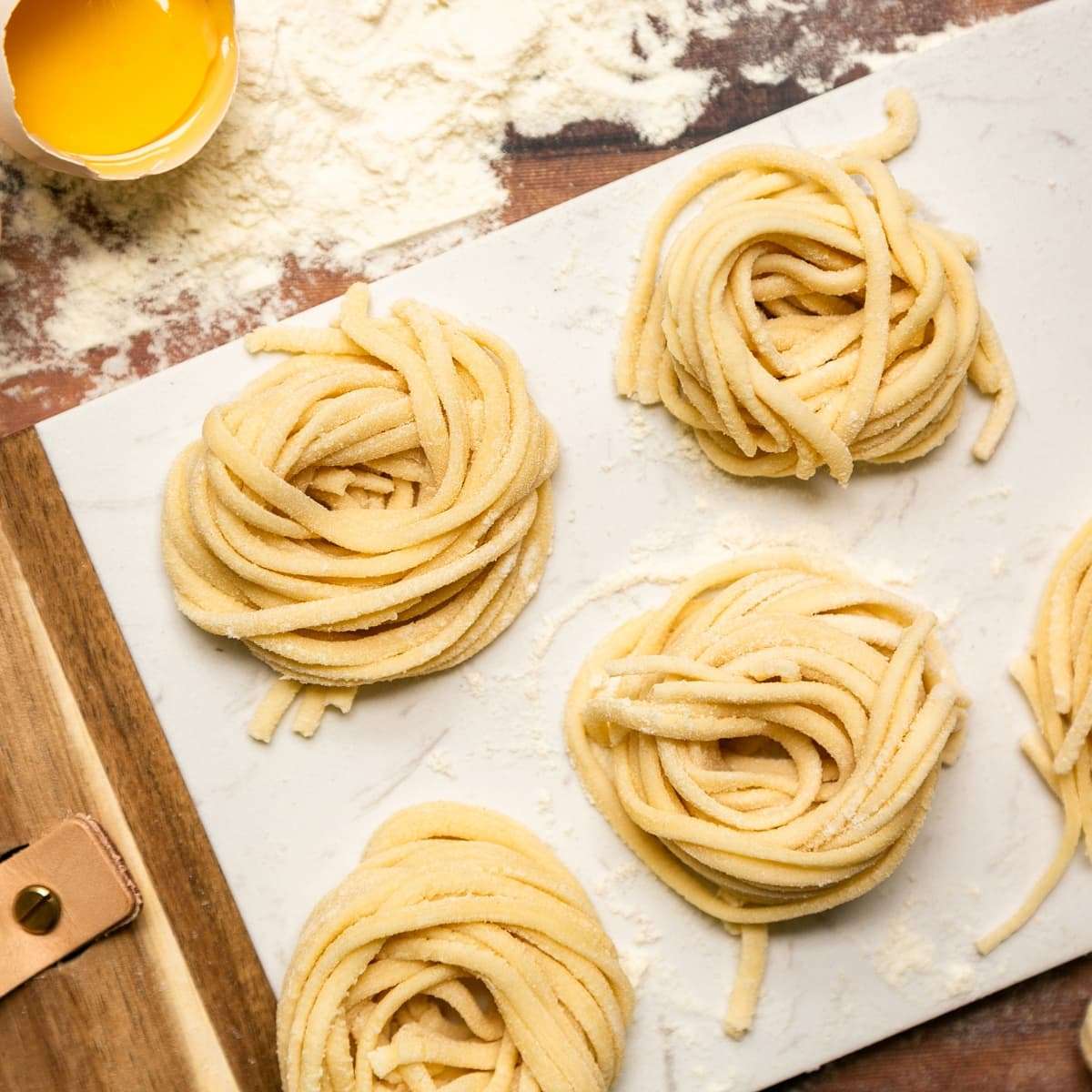
0 from 3 votes
How To Make Homemade Pasta
All the tips on how to make homemade pasta the authentic Italian way, with only 2 ingredients!
Prep Time
15 mins
Cook Time
15 mins
Additional Time
30 mins
Total Time
15 mins
Servings: 4
Calories: 427 kcal
Course:
Main Course
Cuisine:
Italian
Ingredients
- 4 large eggs at least 70 g/2.5 oz each, preferably organic
- 400 g flour 00 or all-purpose flour about 3.2 US cups
Instructions
- Place the flour on a clean work surface and create a hollow in the center.
- Break the eggs, place them in the center of the flour, and start beating them with a fork, incorporating more and more flour while you do that.
- Once you have a well-mixed mixture, knead it with your hands for about 15 minutes until you have a smooth and elastic dough.
- Wrap the pasta dough in cling film and let it rest in a cool dry spot in your kitchen, for 30-60 minutes.
- Cut the dough in half, leaving the remaining dough well covered to prevent it from drying out.
- Sprinkle with a little flour a clean work surface, and roll the dough to create a thin sheet, about 42 cm/ 16-inch wide.
- Dust the surface with a little more flour and roll the dough on itself, like a swill roll.
- With a sharp knife, cut strips about 1 cm/ ⅓-inch wide in order to make tagliatelle pasta. Repeat the process with the remaining pasta dough.
- Gently unroll the homemade pasta obtained, taking care to do it quickly to prevent the dough from drying out.
- Cook the homemade pasta straight away, or form little nests of pasta with your hands and arrange them on a tray, lightly floured, to let them dry slightly, then you can store it in the fridge for up to 2 days, or in the freezer for up to 1 month.
Cup of Yum
Notes
- Use the right flour: The type of flour you use is crucial to the texture of your pasta. Traditional Italian pasta is made with 00 flour, which is finely milled and has a low protein content. If you can't find 00 flour, you can use all-purpose flour.
- I like to use 1 large egg for 100 g of flour, it should weigh at least 70 g/2.4 oz.
- To make the pasta dough more elastic and easier to work with, you can add 1 teaspoon of water to the mixture.
- Knead the dough thoroughly, which is essential to create a smooth, elastic dough. This can take up to 10 minutes, so be patient.
- Let the dough rest: After kneading the dough, let it rest for at least 30 minutes. This will allow the gluten to relax, making it easier to roll out the dough.
- Roll the dough thinly: To create the perfect texture, the dough needs to be rolled out thinly. You can use a pasta machine or a rolling pin to achieve this.
- Cook the pasta in salted boiling water: When cooking the pasta, be sure to use plenty of salted boiling water. This will help to flavor the pasta and prevent it from sticking together.
- Don't overcook the pasta: Fresh homemade Italian pasta cooks much faster than dried pasta, so keep an eye on it while it's cooking. It should only take a few minutes to cook until al dente.
Nutrition Information
Calories
427kcal
(21%)
Carbohydrates
77g
(26%)
Protein
16g
(32%)
Fat
5g
(8%)
Saturated Fat
2g
(10%)
Polyunsaturated Fat
1g
Monounsaturated Fat
2g
Trans Fat
0.02g
Cholesterol
164mg
(55%)
Sodium
64mg
(3%)
Potassium
168mg
(5%)
Fiber
3g
(12%)
Sugar
0.4g
(1%)
Vitamin A
240IU
(5%)
Calcium
40mg
(4%)
Iron
5mg
(28%)
Nutrition Facts
Serving: 4Serving
Amount Per Serving
Calories 427
% Daily Value*
| Calories | 427kcal | 21% |
| Carbohydrates | 77g | 26% |
| Protein | 16g | 32% |
| Fat | 5g | 8% |
| Saturated Fat | 2g | 10% |
| Polyunsaturated Fat | 1g | 6% |
| Monounsaturated Fat | 2g | 10% |
| Trans Fat | 0.02g | 1% |
| Cholesterol | 164mg | 55% |
| Sodium | 64mg | 3% |
| Potassium | 168mg | 4% |
| Fiber | 3g | 12% |
| Sugar | 0.4g | 1% |
| Vitamin A | 240IU | 5% |
| Calcium | 40mg | 4% |
| Iron | 5mg | 28% |
* Percent Daily Values are based on a 2,000 calorie diet.